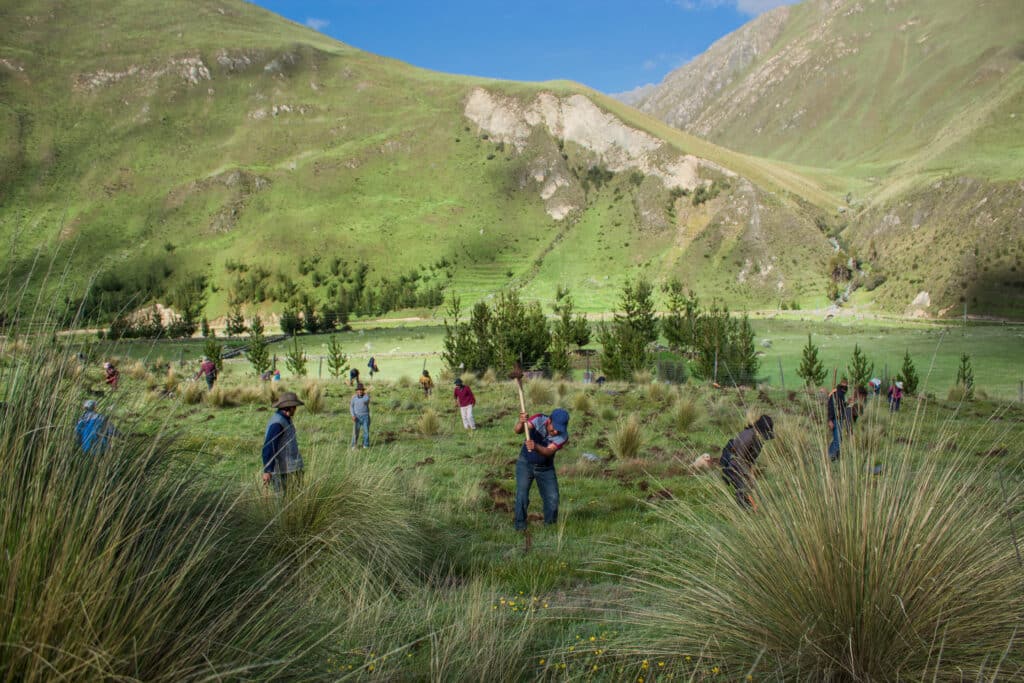Beyond Bees and Trees: How Salesforce Is Flipping Nature Negative to Nature Positive

This past spring, Salesforce unveiled their new campus in Dublin. It is one of the most sustainable buildings in Ireland, with double LEED Platinum certification and powered by 100% renewable energy assisted by rooftop solar panels. It has a green roof to sequester carbon and 60,000 bees to assist with pollination and boost biodiversity in the city.
The apiary captured the attentions of nature lovers around the world for its novelty, but it’s a tiny part of a much bigger undertaking. With around 70,000 employees and relationships with more than 150,000 global companies, the CRM global leader recognizes the responsibility they have to manage their impact on the world – one that they take very seriously. CEO Marc Benioff has said, “Every country, company, community, and person has a responsibility to act now—the cost of failing to address this global threat will be catastrophic. Our generation will be judged by the actions we take on climate change today.”
Recognizing its unique position to drive change, Salesforce this year has embarked on an ambitious journey to not only achieve carbon neutrality but to become nature-positive, attempting to do more good for the environment than harm through their corporate actions.
The new strategy is the latest step in the company’s longstanding record of environmental action. In fact, Salesforce has been on a sustainability journey going back to 2005. The company has achieved net zero emissions across its entire value chain and 100% renewable energy for its global operations. In 2021, Salesforce went beyond its own footprint, announcing its Ecosystem Restoration and Climate Justice Fund to invest $100 million USD over 10 years toward key climate initiatives. Striving for nature positivity is just the latest step for the company who announced it would co-establish the One Trillion Trees initiative, a multi-stakeholder effort to conserve and restore forests by 2030. Salesforce has described the goal as both audacious and feasible.
Capturing these and additional actions in a nature-positive lens helps Salesforce set targets to help ecosystems grow and thrive for a better future, rather than maintain the status quo. They plan to give back to nature by doing things that make plants, animals, and ecosystems healthier like planting trees, protecting wildlife habitats, and using resources in a way that doesn’t harm the planet — and helping other companies to do the same
For Tim Christophersen, Salesforce’s vice president of climate action, restoring nature is more than just his day job – it’s practically part of his DNA. He and his family are foresters by trade in Denmark, where he resides on their farm. In recent months, the Christophersens planted 29,000 trees on the property.
“Right now we are in a nature negative world, which means we’re losing the quality of our ecosystems. And we want to turn that into a nature positive world and getting back to where ecosystems are recovering. That’s not something that a single company like Salesforce can do, but we can contribute to a nature positive world.”
Getting to nature positive is a collective journey. It will take governments, companies, and citizens to do this together and in a coordinated way. But for companies, there are real business benefits to embracing a nature-positive strategy, which not only contributes to the well-being of the planet but also bolsters long-term business viability and competitiveness.

“It goes all the way back to Henry Ford’s philosophy,” says Christopherson. “He recognized that there would only be enough people who could afford a car if workers were paid proper wages. And the same is true now. You can only have business on a planet where people are healthy and not completely overwhelmed by natural disasters and floods and droughts and fires. This should now be an essential part of everybody’s business strategy.”
A nature-positive strategy also often leads to increased operational efficiency and greater resilience against supply chain disruptions. Moreover, investing in nature-positive initiatives can foster innovation, as companies explore new technologies and practices to minimize their ecological footprint.
Salesforce’s Nature Positive Strategy is comprised of three mutually reinforcing areas of action.
- Reduce nature impacts: While Salesforce has a less substantial impact on nature than companies with value chains dependent on natural resources, they are actively managing and working to reduce dependencies on nature in areas like data centers, offices, value chain, people, and products. To accomplish this, the company conducts assessments as part of the Task Force on Nature-related Financial Disclosures (TNFD)’s pilot phase.
- Lead on nature restoration at scale: Salesforce has made both financial commitments and strategic partnerships to foster the preservation and rejuvenation of nature, provide assistance to communities, and fulfill their Climate Action Plan and net zero obligations. The primary focus of Salesforce’s initiatives centers on forest ecosystems exemplified by their dedication to One Trillion Trees (1t.org), but their impact ambitions also extend to innovations that enhance livelihoods and communities and protect oceanic ecosystems. Salesforce supports organizations that partner with communities on the ground to find meaningful, nature-based climate solutions with grants from its substantial $100 million Ecosystem Restoration & Climate Justice Fund. They will also acquire one million tons of top-tier “blue” carbon credits in support of coastal and marine ecosystems such as mangrove forests, seagrass meadows, and salt marshes.
- Accelerate customer success and the nature positive movement: While it may not be immediately obvious, reforestation is an incredible application of the power of their platform. They are using what they do well in the private sector to solve one of society’s biggest global challenges – what some might say is simply business at its best.
Tim explains, “We’re a technology company and we want to bring that superpower of tech to the aid of nature and the climate.” The company is working on developing a suite of technology tools that can help their customers better measure their nature footprint – a major challenge for many in the private sector. Rapid advancements in artificial intelligence are making the tools much more powerful.
Salesforce is a company that can solve for big data management challenges, especially when a lot of stakeholders are involved. They are able to record exactly which investments are made, the key players involved, the location of those projects, and impact indicators from on the ground. As an example, they are not only tracking the number of trees saved or replanted, but also measuring the impacts those trees have on the surrounding biodiversity. In measuring the forest area in the Andes Mountain Range, they can better understand restoration of the high mountain forest watersheds and what it takes to provide clean drinking water in Peru and other Andean countries. “We’re building this on Salesforce technology because we’re a company that can solve for any of these big data management challenges, especially when a lot of stakeholders are involved.”
The last component is critical. While bees and trees get a lot of media headlines, this alone is not enough. Salesforce has the platform and the reach to get others “off the bench” on solving the climate crisis. Enabling their customers with the tools and information on how they can best and most easily enter the space is a small stone that could start an avalanche of onward action.
They also have a powerful workforce that is passionate about the long-term health of the planet. There are 14,000 volunteers in what the company calls its “Earth Force.” Sustainability-minded volunteers may take up to one week of paid leave per year for efforts that align with the company’s Climate Action Plan, such as tree planting or ocean cleanups. A green team, like Earthforce, provides an avenue for employees to connect on similar passions while affecting positive change.
With a global presence spanning hundreds of thousands of corporate customers, thousands of employees, and numerous corporate partnerships, Salesforce recognizes the magnitude of its role in shaping a sustainable future. By aspiring not only to achieve carbon neutrality but to actively contribute to the flourishing of nature, the company has set a compelling precedent they hope others will be inspired to follow and learn from.
View Salesforce’s Council profile, including six unique commitments to action.
